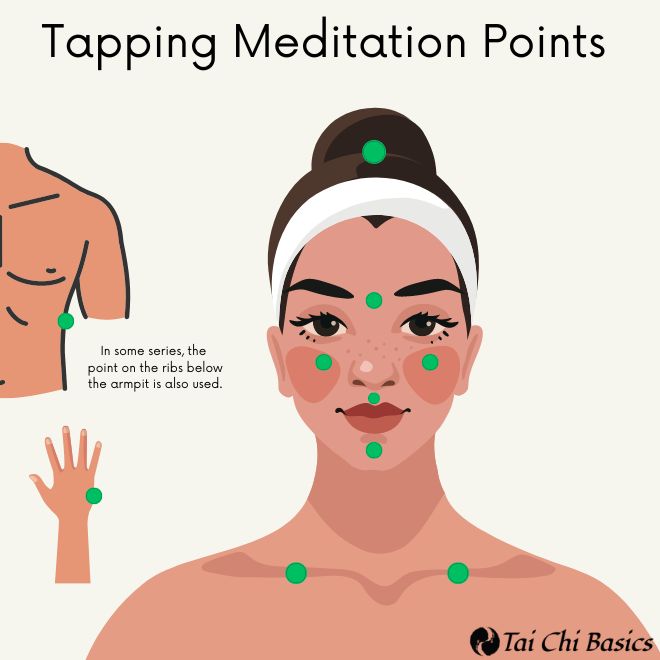There is a frustrating aspect to trying to make any change in life: We are not always sure why we’re not getting the results we want or making progress. In the best of circumstances, we hire or know a knowledgeable person who can point out something we could be doing differently. In the worst of circumstances, we beat ourselves up for not improving and are left feeling deflated and judgmental rather than inspired. Tapping meditation is a modern tool built on ancient processes that enables us to get past what we may not know actually getting in our way.
Tapping Meditation is the process of focusing on negative thoughts, emotions, physical pain, or something we want to change while tapping acupressure points to trigger neurological responses leading to relaxation. This combination disassociates the problem from negative emotion or beliefs so that the problem dissolves and we experience change.
I find that with a slight understanding of the science and origin of the process, a person gains the buy-in needed to give tapping meditation a shot. There is no downside such as cost or the time it takes to find a teacher or attend a class. You just need about 20 minutes and proper instruction. Let’s start with the history and then dive right into meditation tapping techniques so that you can experience the benefits.

The History of Tapping Meditation and Current Popularity
Tapping meditation is new to most people but the truth is that it is just finally getting its day in the sun. Its origins can be traced back to traditional Chinese medicine, where the idea of energy meridians and their influence on health has been recognized for centuries. Central to the effectiveness of Tapping meditation is the belief in the existence of subtle energy pathways, or meridians, within the body. These meridians are thought to be interconnected with our physical and emotional well-being. By tapping on specific points associated with these meridians, practitioners can release blocked energy and promote emotional release and healing.
In the Western world, the earlier version of tapping called Emotional Freedom Technique (EFT) was developed by Gary Craig in the 1990s, drawing inspiration from both Eastern philosophy and modern psychology. Since then, it has gained widespread recognition and acceptance in the field of holistic wellness even evolving into an annual Tapping World Summit. While there are many practitioners and teachers at this point, I want to pay special credit to Richard Trubo and Roger Callahan who synthesized tapping into a framework in their 2001 book “Tapping the Healer Within.”
Purpose and 5 Benefits of Tapping Meditation
Tapping Meditation serves a multifaceted purpose; it can help with issues we know about concretely such as pain or disease and also issues where we are not positive what the cause is. This is one area where I will ask for a small amount of latitude and head into the esoteric. Let’s say your business is not progressing like you want. Is it because you are tired, have low self-esteem, are not confident about your decisions, are inexperienced and therefore overwhelmed? Suffering from a forgotten childhood trauma? Under the shadow of a past-life aggression? All of the above?
I’m (slightly) joking here but can we know for sure what limits our progress? The answer is no. Tapping meditation has the ability to help us be okay with not knowing and still move ahead in life. With 100% certainty we know what we are feeling in this moment and what outcome we would like. We concentrate on these knowns during tapping meditation and calm our neurological reaction by lightly striking acupressure points to illicit feelings of wellbeing. The benefits of tapping meditation shared by practitioners include:
- Stress Reduction: Tapping Meditation is a powerful stress management tool. By tapping on meridian points and acknowledging emotions, individuals can alleviate tension, promote relaxation, and experience a greater sense of calm.
- Emotional Release: This technique enables individuals to confront and release buried emotions, traumas, and negative thought patterns. It provides a safe and structured way to process and let go of emotional baggage.
- Pain Management: Tapping has shown promise in reducing physical pain and discomfort. By addressing the emotional components often associated with chronic pain, individuals may experience relief.
- Enhanced Emotional Well-Being: Tapping Meditation fosters emotional resilience, leading to improved emotional well-being. It empowers individuals to address issues like anxiety, depression, and phobias effectively.
- Improved Self-Acceptance: Through the practice of self-acceptance in the setup phase, Tapping Meditation encourages individuals to be kinder and more compassionate towards themselves, promoting a positive self-image.
Explanation of the Tapping Process
The core of Tapping Meditation lies in the systematic tapping of specific meridian points on the body while focusing on the emotional or physical issue at hand. The process can be summarized as follows:
Identify the Issue
Begin by acknowledging the specific issue you wish to address. It can range from stress, anxiety, or past trauma to physical pain and negative emotions. You don’t have to understand why you have the issue, simply identify it.
State your experience verbally trying not to associate yourself with the problem. For example, rather than saying: “I’m angry, in pain, or overwhelmed,” State “I feel anger, I am experiencing pain, or I feel overwhelmed.” Make it about your experience, not about who you are as a person.
Rate the Issue
On a scale of 1-10, how badly are you affected by it? This is important for you to be able to see the progress that you make from the begging to the end of a session and across several sessions.
Begin the Tapping Sequence
Close your eyes and begin tapping the series of acupuncture points starting with the sides of your hands and then transitioning from the top of the head down to the ribs. As you tap each point, repeat a reminder phrase that summarizes your issue. Continue tapping through a prescribed sequence, which includes points on the head, face, upper body, and hands.
Tapping Meditation Points
- Sides of the Hands
- Crown of the Head
- Between the Eyebrows
- Temples
- Cheekbone Under the Eyes
- Upper Lip Under the Nose
- Chin Below the Lower Lip
- Collarbones

Transition to Acceptance
You are going to go through the process two more times. In this next sequence, accompany your concern with a statement of acceptance. Go through the sequence of tapping meditation points but this time say something like: “Even though I feel anxious about the upcoming interview, I am confident I will do my best.” It is important that this portion is believable to you. A tip here is to use the phrase “in the process of” like: “Even though… I am in the process of learning how to…”
Transition to Positive Belief
Begin the tapping sequence again but this time use a positive, believable statement. An example could be: “Although I feel pain in my back, it is less because I am healing.” Most people transition slowly through the tapping sequences for a total of 10-20 minutes.
Reevaluation
After completing the tapping sequence, take a moment to reassess your emotional state. Many practitioners find that their distress has significantly diminished or even disappeared altogether. Don’t skip this step because it is crucial to get continued benefit from tapping. Often in life it is difficult to remember a pain or problem that is gone. By taking time to evaluate yourself at the beginning and end, you can more correctly attribute your progress or tapping.
Here is a fairly good overview by one of the current leading teachers of tapping meditation, Nick Ortner.
Tapping Meditation for Anxiety, Weight loss, and Wealth
With several decades of research into tapping, the process has become more specific for addressing specific issues. These range from mental and physical health issue to the application of tapping to get past limiting beliefs that can negatively impact professional and personal goals. As an example, here are three resources.
My suggestion is that if you have a specific goal, to go in the direction of reading rather than tapping meditation videos on YouTube. I for one love the easy and accessibility of most videos but the truth is that in writing this essay I came across many sets that were incomplete or didn’t address the problem fully.
I am not against tapping videos, but I suggest that you do your search in reverse. Look for authors of full books because they typically have the credentials and have thought through the process completely. Then search for them specifically and see what resources they have produced online.
The Tapping Solution: by Nick Ortner
The Tapping Solution for Weight Loss & Body Confidence: A Woman’s Guide to Stressing Less, Weighing Less, and Loving: by Jessica Ortner
Tapping Into Wealth: How Emotional Freedom Techniques (EFT) Can Help You Clear the Path to Making More Money: by Margaret M. Lynch (Author), Daylle Deanna Schwartz M.S.
And my Favorite:
Tapping the Healer Within: By Richard Trubo and Roger Callahan
“Tapping the Healer Within” delves into the world of energy psychology, specifically focusing on Thought Field Therapy (TFT), a therapeutic technique developed by clinical psychologist Roger Callahan. TFT combines elements of psychology, acupuncture, and energy medicine to address emotional and psychological issues. The book provides practical guidance on how to use TFT, also known as “tapping,” to alleviate a wide range of emotional and physical problems.
Through “Tapping the Healer Within,” readers are introduced to the concept of meridians, the body’s energy pathways, and how tapping specific points on these meridians can effectively release emotional distress, reduce anxiety, eliminate phobias, and address various psychological issues. The authors offer real-life case studies, testimonials, and step-by-step instructions on how to apply TFT for self-healing and personal growth.
If you are new to meditation or are looking for a way to expand your practice, this is one of 17 essays we wrote on different styles of meditation. Find a style that matches your personality and goals.



